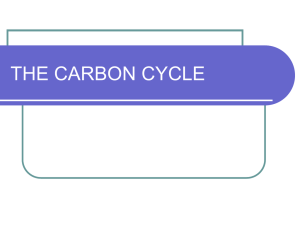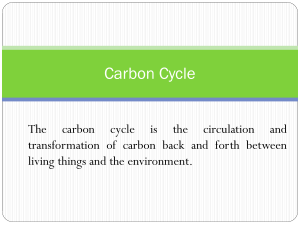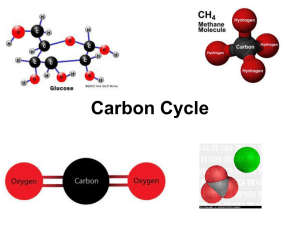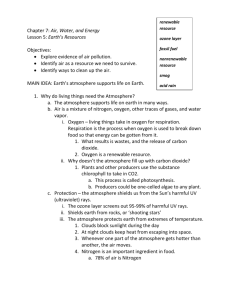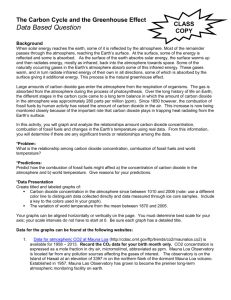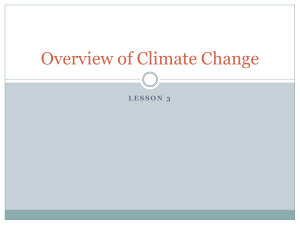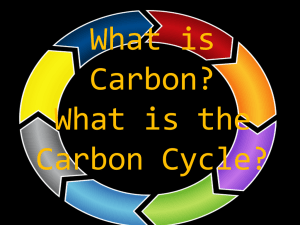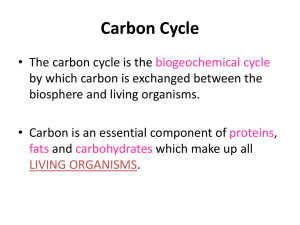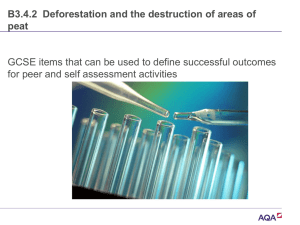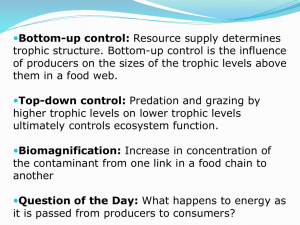PowerPoint Presentation - THE CARBON CYCLE
advertisement
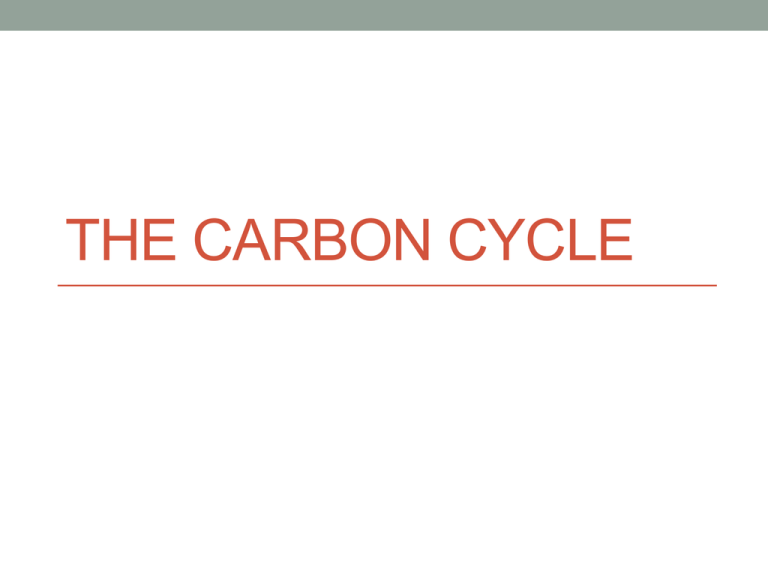
THE CARBON CYCLE What Is Carbon? • Carbon is the chemical element with symbol C and atomic • • • • number 6. As a member of group 14 on the periodic table, it is nonmetallic and tetravalent—making four electrons available to form covalent chemical bonds. Carbon is a nonmetal that can bond with itself and many other chemical elements, forming nearly ten million compounds. The basis of life of earth-all living things have it Found in rocks, oceans, atmosphere Carbon is the fourth most abundant element in the universe (hydrogen, helium, and oxygen are found in higher amounts, by mass) Carbon Carbon exists in the nonliving environment as: • Carbon dioxide (CO2) • Carbonic acid ( HCO3−) • Carbonate rocks (limestone and coral = CaCO3) • Deposits of Fossil fuels • Dead organic matter Carbon Cycle • The same carbon atoms are used repeatedly on earth. They cycle between the earth and the atmosphere. Plants Use Carbon Dioxide • Plants pull carbon dioxide from the atmosphere and use it to make food –— photosynthesis. • The carbon becomes part of the plant (stored food). Animals Eat Plants • When organisms eat plants, they take in the carbon and some of it becomes part of their own bodies. Plants and Animal Die • When plants and animals die, most of their bodies are decomposed and carbon atoms are returned to the atmosphere. • Some are not decomposed fully and end up in deposits underground (oil, coal, etc.). Carbon is released into the atmosphere in several ways • Respiration by plants and animals. • Decay of animal and plant matter. • Combustion of organic material • Production of cement. • The ocean releases CO2 into the atmosphere. • Volcanic eruptions and metamorphism Carbon Slowly Returns to Atmosphere • Carbon in rocks and underground deposits is released very slowly into the atmosphere. • This process takes many years. • See Animation CARBON POOLS Pool Atmosphere Terrestrial Plants Soil Organic matter Ocean Fossil Fuel Deposits Marine Sediments and Sedimentary Rocks Amountin Billions of Metric Tons 578 (as of 1700)- 766 (as of 1999) 540 to 610 1500 to 1600 38,000 to 40,000 4000 66,000,000 to 100,000,000 Carbon is stored on our planet in the following major pools: • as organic molecules in living and dead organisms found in the biosphere; • as the gas carbon dioxide in the atmosphere; • as organic matter in soils; • in the lithosphere as fossil fuels and sedimentary rock deposits such as limestone, dolomite and chalk; • in the oceans as dissolved atmospheric carbon dioxide and as calcium carbonate shells in marine organisms. 2/12 Carbon Cycle CYCLE – REPEATS OVER AND OVER AND OVER AND OVER … Carbon Cycle Diagram Carbon in Atmosphere Decomposers break down dead things, releasing carbon to atmosphere and soil Fossil fuels are burned; carbon is returned to atmosphere Carbon slowly released from these substances returns to atmosphere Plants use carbon to make food Plants and animals die Bodies not decomposed — after many years, become part of oil or coal deposits Animals eat plants and take in carbon Carbon in Oceans • Additional carbon is stored in the ocean. • Many animals pull carbon from water to use in shells, etc. • Animals die and carbon substances are deposited at the bottom of the ocean. • Oceans contain earth’s largest store of carbon. The Carbon Cycle Human Impact • Fossil fuels release carbon stores very slowly • Burning anything releases more carbon into atmosphere — especially fossil fuels • Increased carbon dioxide in atmosphere increases global warming • Fewer plants mean less CO2 removed from atmosphere HISTORICAL ATMOSPHERIC CO2 CONCENTRATION This figures shows that the concentration of CO2 has never been grater than 300 ppmv for the past 400,000 years. 7/12 ATMOSPHERIC CO2 CONCENTRATION-1 Accurate and direct measurements of the concentration of CO2 in the atmo began in 1957 at the South Pole and in 1958 at Mauna Loa, Hawaii. 4/12 TRACING MATTER Environmental Literacy Research Group Grandma Johnson ? Describe the path of a carbon atom from Grandma Johnson’s remains, to inside the leg muscle of a coyote. NOTE: The coyote does not dig up and consume any part of Grandma Johnson’s remains. A Solution • When she dies, she will be decomposed by tiny bacteria and fungi. As this happens, carbon is released into the soil, which in turn is taken up by the plant roots as nutrients. The plant in turn gets consumed by a small herbivore, who is then consumed by the coyote • As Gma decays, carbon atoms are released into the soil. The bush she's buried under absorbs the carbon as nutrients. A rabbit may eat part of the bush which has the atom in it, and then that rabbit may be eaten by the coyote and absorbs the carbon atom into its muscles for energy use What We Need to Do • Burn less, especially fossil fuels • Promote plant life, especially trees

